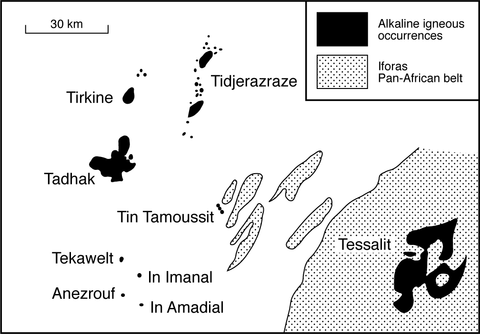stripes
The northern part of this complex, which is 15 km from east to west, is obscured by Quaternary sediments. An outer incomplete ring and the arcuate disposition of some rock units are indicative of a ring-complex. The intrusion is emplaced in 2000 Ma Eburnean gneisses and granites. The outermost unit is a fine-grained nepheline syenite with a fluidal texture which dips steeply inwards. The rock contains microcline and a little perthite, nepheline, aegirine-augite, biotite, titanite and magnetite. The most extensive rock type is a nepheline syenite of microcline perthite, nepheline, partly altered to cancrinite, barkevikite/hastingsite, biotite, aegirine-augite, magnetite, titanite, apatite and zircon with a little interstitial calcite. This rock is somewhat heterogeneous with mafic concentrations and areas of pegmatitic or aplitic texture. An arcuate body of nepheline syenite within this rock is characterised by the absence of perthite but presence of a micropegmatitic intergrowth of nepheline and albite which locally forms orbicular structures. Aegirine-augite, rare biotite and accessory titanite and magnetite are also present. A unit towards the centre of the complex conforms to the annular structure and consists principally of melteigite with <30% nepheline, titanaugite, barkevikite, biotite, titanite, apatite and magnetite. In places this rock grades into ijolite with about 50% nepheline, aegirine-augite, biotite, titanite and magnetite. This facies contains enclaves of pyroxenite displaying cumulate textures and consists of titanaugite, apatite and accessory titanite and biotite. There is one outcrop of glimmerite. All these rock types are cut by foyaite and tinguaite dykes. The foyaite dykes are granular rocks of microcline perthite, nepheline, albite, biotite, barkevikite, titanite and apatite while the paradoxically named tinguaite dykes have a fluidal texture and contain phenocrysts of microcline, nepheline, biotite and aegirine in a mesostasis of nepheline, alkali feldspar and cancrinite. Carbonatites are present as dykes and in a circular 1 km diameter plug east of the complex. The rock of the plug is coarse-grained and there is a little phlogopite. The dykes are rich in apatite, opaque phases and fluorite (Fabre et al., 1982).
FABRE, J., BA, H., BLACK, R., CABY, R., LEBLANC, M. and LESQUER, A. 1982. La Chaine Pan-Africaine, son avant-pays et la zone de suture au Mali. Notice explicative de la carte geologique et gravimetrique de l'Adrar des Iforas au 1/500 000. Republique du Mali, Ministere de l'Energie et des Mines, 85pp.LIEGOIS, J.P., SAUVAGE, J.F. and BLACK, R. 1991. The Permo-Jurassic alkaline province of Tadhak, Mali: geology, geochronology and tectonic significance. Lithos, 27: 95-105.WEIS, D., LIEGEOIS, J.P. and BLACK, R. 1987. Tadhak alkaline ring-complex (Mali): existence of U-Pb isochrons and "Dupal" signature 270 Ma ago. Earth and Planetary Science Letters, 82: 316-22.


